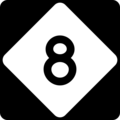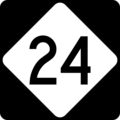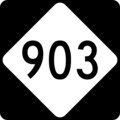List of state highways in North Carolina facts for kids
  
NC primary state route shields
|
|
Quick facts for kids System information |
|
|---|---|
| Length: | 79,328 mi (127,666 km) |
| Notes: | Largest state-maintained highway network in the United States; state roads maintained by the NCDOT. |
| Highway names | |
| Interstates: | Interstate X (I-X) |
| US Routes: | U.S. Highway X (US X) |
| System links | |
| North Carolina Highway System | |
Imagine a giant spiderweb covering all of North Carolina, connecting every town and city. That's a bit like the North Carolina Highway System! These roads are super important. They help people travel, deliver goods, and connect communities across the state. The North Carolina Department of Transportation (NCDOT) owns and takes care of all these roads. In fact, North Carolina has the largest state-maintained highway network in the entire United States!
Contents
What are State Highways?
State highways are roads that are managed by the state government. They are different from local roads (like the ones in your neighborhood) or national highways (like U.S. Routes or Interstates). North Carolina's state highway system was first created in the 1920s.
How are Highways Numbered?
When the system first started, it was very organized:
- Main roads that went across the state often had two-digit numbers ending in "0" (like Highway 50).
- Other two-digit roads were like "branches" off these main routes (so, Highway 54 might branch off Highway 50).
- Less important roads were given three-digit numbers. These numbers were made by adding an extra digit to the two-digit road they branched from (for example, Highway 541 might branch off Highway 54).
Over the years, many small changes have been made to the highway numbers. Roads are sometimes removed, combined, or given new numbers. There have been four big times when many roads had to be renumbered:
- In 1933–1934, some state roads were changed to avoid having the same numbers as U.S. Routes.
- In 1937, numbers were changed so they would match roads in South Carolina at the state border.
- In 1940, numbers were changed to match roads in Virginia.
- In 1961, numbers were changed because of new Interstate highways being built.
Because of all these changes, the original numbering system is not as clear as it used to be.
Interesting North Carolina Highways
North Carolina has many different state highways, each with its own story. Here are a few examples:
- NC 24: This is the longest state highway in North Carolina! It stretches for 278 miles, connecting Charlotte in the west to Morehead City on the coast. Imagine driving across almost the entire state on one road!
- NC 400: This is the shortest state highway, only 0.6 miles long! It's located in Manteo and leads to the Roanoke Island Festival Park.
- NC 3: This highway was renumbered in 2002 to honor famous NASCAR driver Dale Earnhardt. It runs from Concord to Mooresville.
- NC 12: This road is a National Scenic Byway and runs along the Outer Banks, offering amazing views of the ocean. It's a popular route for tourists.
- NC 128: This highway leads to Mount Mitchell State Park, which is home to the highest peak east of the Mississippi River. It's the highest elevated highway in the eastern United States!
Different Types of State Routes
Besides the main state highways, North Carolina also has special types of routes:
Alternate Routes
North Carolina used to have many "alternate" routes. These were like different paths for a main highway. They could be:
- Business routes: These go through the downtown areas of cities and towns.
- Bypass routes: These go around cities to help traffic avoid busy areas.
- Cut-thru routes: These were shorter paths.
- Spur routes: These were short roads that branched off a main highway.
After 1960, the state stopped creating new alternate routes. Most of the old ones were either removed or changed into "business loops." Today, there are only three active alternate routes left in the state.
Business Loops
North Carolina started creating "business loops" in 1960. These are special roads that branch off a main highway, go through a town's business district, and then connect back to the main highway. They are designed to help people get to shops and services in town centers.
Other Special Routes
Sometimes, North Carolina uses other unique types of special routes, like:
- Bypass routes: These roads help traffic go around a busy area. For example, NC 87 has a bypass around Sanford.
- Connector routes: These roads connect two other highways.
- Spur routes: These are short roads that lead to a specific place, like NC 159, which leads to the North Carolina Zoological Park.
Images for kids
See also




